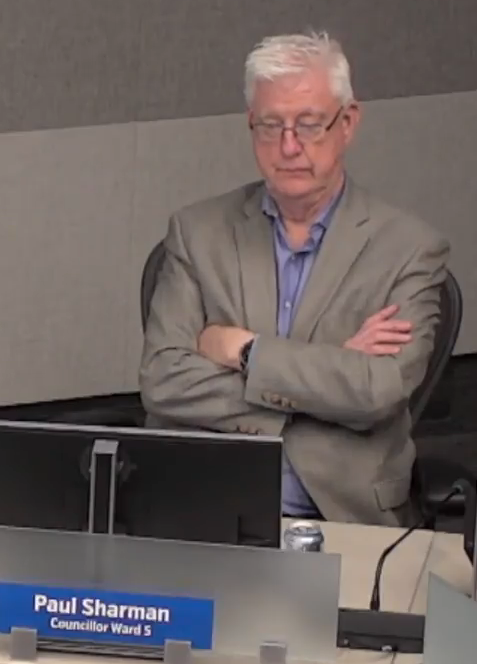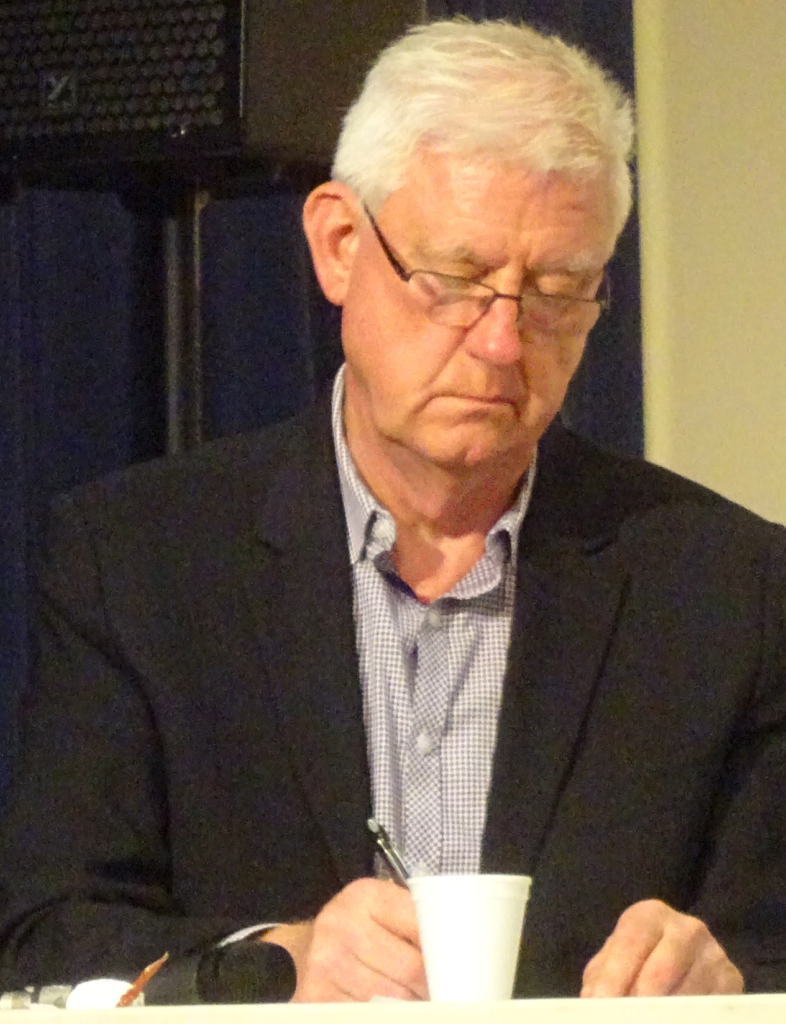 By Paul Sharman
By Paul Sharman
February 17th, 2022
BURLINGTON, ON
Meanwhile, the plan requires that 80% of all new development, to accommodate the 450,000 new residents, will be densified. The difference between urban expansion scenario and under NUBE will mean that newcomers who would otherwise like to live in Halton will be forced to move to other regions of southern Ontario. This makes it unlikely that the Region will achieve its population growth targets, which is unacceptable to the province.”
I am entirely respectful and sensitive to the many comments I have received from “Stop Sprawl Halton” and today’s delegations. Without any doubt they are passionate, highly alert, and with varying levels of being informed on the matters about which they spoke. They are also correct on many of their points. I wish to thank them for taking the time to speak to Council.
Recently I responded to an email from one of the leaders of the movement, one who might have delegated.
You may know already but allow me to tell you a little about myself. I am the Burlington Councillor who strenuously and successfully argued that climate change mitigation should be added to the City of Burlington’s 2015, 25-year, strategic plan.

Sharman – an avid cyclist.
This was 4 years before anyone declared a climate change emergency. That plan continues to act as a guiding vision for the community. I drive an electric vehicle that was used when I purchased it and I ride a pedal bicycle many km’s every week when the weather warms up. I installed a tankless water heater and a heat pump in my house along with new windows, doors, and insulation. I do not eat red meat, preferring vegetables. Between us, my partner and I have 4 children and 7 grandchildren about whose future we care passionately. Finally, I have served 11 years on the Burlington Sustainable Development Committee. All the matters that concern you with respect to sustainability also concern me.
In summary, I am highly informed and care deeply about the future of our community. My purpose is to make a contribution to the best of my ability.
Burlington’s agricultural and heritage land is dominated by Niagara Escarpment and other heritage attributes, which have been protected by the Region and Burlington Councils from development for decades. In the past the land that we live on was converted from what was previously, largely, farmland. Burlington has now essentially depleted its developable green field land.
That said, employment land is being converted to accommodate growth. Indeed, in the current IGMS plan Burlington is required to undertake massive population growth and densification as will the rest of Halton.

Sharman: He can be impatient at times but more often that note he has figured out what the issue is and presses the point.
My representation of the citizens of Burlington includes acknowledgement of their opposition to “over intensification”, which I agree has had a heavy orientation to downtown. That was the concern of 46% voters in the 2018 election. That said, most of those people do not live downtown and are generally concerned about what they consider to be excessive population growth, road congestion and not wanting to live in a highly densified community.
Any of concepts of the Region’s IGMS allocation leaves Burlington the recipient of residual population that is not allocated/accepted by other Halton lower tier municipalities. I appreciate that City staff have indicated Burlington can accommodate larger numbers of residents, but Council has not been provided any detailed analysis of location or building types required to accommodate such growth. According to a rough estimate by Mr. Benson, Halton Director of Planning, 15,500 new residents will require forty five 30 storey buildings. Because Burlington is already built out, the Hemson Consulting report of early 2021 estimated that 90% of the increase in Burlington’s population growth will have to be housed in mid to high rise buildings. 70,200 new residents allocated to Burlington under the preferred growth concept equates to 63,180 new apartment residents in 183 x 30 story buildings using Mr. Benson’s math.
If the preferred growth concept is not approved, Burlington’s allocation may increase to 85,700, of which 90% or 77,130 would likely have to live in apartments. That means Burlington will need to accommodate, perhaps 228 x 30 story towers. That is a rather daunting vision, equating to, perhaps, 5 times + the equivalent of Mississauga’s Square One neighbour hood, but in smaller spaces.
All of that said, my over-arching concern is whether there is a high probability that
a) 450,000 more people will become residents of Halton in the next 30 years
b) what the probability is that in the following 50 years another 750,000 will arrive at the same rate.

Sharman: “… all plans, by definition, are wrong and therefore it is tough to reach finite conclusions.”
In truth, I believe that all plans, by definition, are wrong and therefore it is tough to reach finite conclusions. Therefore, we have to make broad assumptions on probabilities. My sense is that Halton will, receive more than the province’s “minimum” required 450,000 new residents between now and 2051 and it will not end there because increased immigration levels and other global motivators that cause people to leave their home countries.
That leads to the question that weighs heavily on my mind: on balance between all the hard choices to be made, if municipalities fail to make the decisions that represent the best long-term outcomes for the future, then the probability of bad outcomes escalates.

Any hope to ever own their own home locally because of incredible price increases and lack of supply is in doubt..
An example of a bad outcome is reflected in conversations I had recently with two young Burlington university graduates who both live in their parent’s homes. Neither sees any hope for them to ever own their own home locally because of incredible price increases and lack of supply. Perhaps, as many as 100,000 of Halton’s current young residents are in the same boat with them. Housing is critical to everyone. Without sufficient housing, countries get massive inequality, social injustice, and social unrest. Canada is already getting there.
While I do not want to see expansion of urban boundaries, I do want a balanced and fully informed set of decisions to be made by Council. Decisions of the past allowed 80% of current Halton residents who are older than, about, 35 to have had a chance to achieve high quality housing. Those of us who are in the much older age group of Halton homeowners live in relative luxury by the standards of many people in Canada and around the world.
Is it reasonable to suggest that the tenets of our great Canadian democracy including free speech, freedom of choice, free markets etc. will not be available, at least to some degree, to our children and grandchildren? Is it possible for Canada to decline immigrant’s entry when our economy badly needs them to overcome the effects of people living 30 years longer than when Medicare was introduced in the 1950’s. What comes next if we don’t consider all the factors.
The decisions we make today will affect the quality of life of hundreds of thousands of future Halton residents. Many will not have it as good as we have. Councils in Halton Hills and Milton are in the best position to assess all the questions raised by delegates today, to make their own informed highly informed complex decisions about how their communities should develop in future and I fully respect their insight, the professionalism of their staff and their sincerity.
There has been a lot of discussion about fighting climate change by not permitting urban expansion. Irrespective of where new population and jobs end up there will be GHG emissions, but they will be a bit less in the no urban boundary expansion (NUBE) scenario. I quote the Region’s FAQ:

Sharman: Have your data in front of you and be prepared to be challenged.
“While Concept 3A/3B was evaluated as the concept that generates the least amount of community GHG emissions, as part of its evaluation it did not score well in addressing many other important community planning and housing objectives, some of which are identified in the response in Question 1 of these FAQ’s”
It is not clear what the impact of the preferred concept will be on food security. Delegations have spent a lot of time talking about saving farmland. According to the farmers of these properties, these lands have been designated as “White Belt” or land to be developed, eventually, for decades. These farms mostly grow grain, beans and seed that is shipped to other markets elsewhere in Canada and the world. They also noted that these farms are increasingly surrounded by, and production inhibited by, the urban development encroaching around them.
Nobody talked about the total 160 million acres of farming in Canada of which .003% this change represents. Not to suggest that the 5000 acres is irrelevant, indeed the recommendation to convert the land has been the subject of a couple of years of study senior professional staff and consultants costing $100,000’s.

Intense to the point of making delegations uncomfortable ward 5 Councillor Paul Sharman does know how to drill down into the data and look for results.
Meanwhile, the plan requires that 80% of all new development, to accommodate the 450,000 new residents, will be densified. The difference between urban expansion scenario and under NUBE will mean that newcomers who would otherwise like to live in Halton will be forced to move to other regions of southern Ontario. This makes it unlikely that the Region will achieve its population growth targets, which is unacceptable to the province.”
It also represents passing the buck to other Regions whose farmland will likely still be built on.
Finally, it is not clear how the province will respond to a significant variance from the directions given for preparation of the new official plan. This a tough situation for elected official to be placed in. We all want everything to be done right and in the right way. But, throughout my career I have always found that in the absence or avoidance of fact the person with the loudest mouth wins.
Paul Sharman is the ward 5 Councillor in Burlington and a Regional Councillor as well. He is serving his third term in public office. He is a huge believer in basing decisions on data and is seldom shy about making his views known
Related news story:
Two mayors flip a Regional recommendation.




















Greg.
Some quick information on housing costs and housing types. Starting from least expensive.
1. Midrise condo’s (land cost reasonable, 50 to 60 thousand per unit, construction cost in lumber. Cheapest of all per sq. ft.) Selling price average $900 per sq. ft.
2. Highrise condo. Land costs are low, split over that many units Selling $1,000 per sq. ft per unit.
3.Townhouses ( Land cost starts to become an issue) Newer unit in the downtown could push $1,100 to $1,300 per foot. Less as you move North Burlington. You get a front yard and back yard.
4. Single family home. (Land costs are now 3/4 of the price of the whole house. Remember this is one of the biggest countries in the world.) People should be put in jail for this level of incompetence that has created this housing land shortage. We will not forget to include the cost of building more jails. A simple 2 storey new home 1,900sq ft fetches $1,157 thousand per square foot. Don’t forget you get front and back yards, side yards too.
Highrise building use up the least amount of land per unit. Single family homes use the most. You decide.
It’s a choice of quality of life (ground level living) over quantity of little stacked matchboxes (high rises).
Quality of life is a consumer preference. Cost/profit is a developer preference.
Consumer preference would tend to be the highrises, as that is what is being sold.
If developers proposed projects and no one bought them, they’d stop building them. It the way our markets work. Supply and Demand, if there is no demand, they wouldn’t be built.
You are confusing what YOU want with what the purchasers want.
Bob. That’s a mis-guided thought process.
If all, or practically all, that is being built are high rise stacked matchboxes, what choice does the consumer have.
The high rise matchboxes are the most efficient and profitable (for the developer) use of expensive land.
Look at the recently completed townhouse projects at New St and Martha Street & New Street and Cumberland Avenue. Built and sold out in a flash. Please don’t say there is no appetite for low rise living. But the sale prices were out of the range of twenty something first time home buyers
Look at Liberty Village in the west end of Toronto. It is a super congested area of high rises inhabited by twenty somethings. It’s party central. But it comprises mostly rental units rented out by older generations who hold the properties as investments. Why do the young live there. It is all they can afford – to rent, not buy. To buy a 400sq ft one bedroom apartment costs $600,000+. To buy one needs a 10% deposit ($60,000) and the ability to qualify for a $540,000 mortgage. To qualify one would need a before tax annual income of $100,000 !
You are right about supply and demand. The demand is for housing. The developers meet that demand primarily via high rise matchboxes. No choice offered. The units are bought by those who can afford them. That does not include the younger generations.
“Plans are useless, but planning is invaluable” – Winston Churchill
In a way, Councilor Sharman reflects on this in his text, but I think he misses the wisdom of the point.
It’s easy to confuse plans with planning. With a plan you never know what will happen in action, or know what you will get, what will be a good outcome and so on.
The Provincial Growth Plan, and associated policies, that are at the heart of the topic here, are in fact a dagger in the heart of planning. In Burlington and Halton, it has destroyed planning itself.
It substitutes a central dictatorial control over development, with fabricated numbers, that tells the Regional and Local governments what they have to do , and for how many people. It also provides a legal process that allows any development application, if the City doesn’t want to approve it, to be appealed to a Tribunal that decides based on their interpretation of the Growth Plan.
As a result, Burlington has 2 Official Plans that are effectively zombie plans – one is an old one that is in force and effect, but obsolete; and a second, approved OP, that is effectively dead in a mass appeal of it at OLT. The result is that planning itself is confused with the Growth Plan and is subverted.
The Growth Plan, and supporting policies, and open and free resort to OLT, are the instruments of this oppression of citizen rights (they have no meaningful rights at OLT) and the subversion of planning the actual development process and form.
What other Growth Plan would tell the Region and City that it has to spend the next 30 years effectively doubling their population, adding all the accoutrements of life for the life support of 500,000 people? It’s telling us that we have to focus our community to serve this goal without exception, so it will become the most important thing we have to do, regardless, or else.
And Councilor Sharman tells us about his environmental credentials, and his leading role in declaring a climate change emergency in the City long ago, all admirable, but this emergency is just accelerating and will have profound impacts over this same 30 year period that we are supposed to be doubling our population. This disconnect is madness, borne of power and greed.
So in short form, this is the essence of this discussion and crisis of self determination in our future.no unrban boundary expansions
The wisdom that I think the Councilor misses is that we can’t have our cake and eat it – we can’t have an unthinkable and obedient devotion to perpetual growth in population and everything else that will be consumed, and really anything else satisfactory or healthy.
Between the Cilimate Change exponentially kicking in as we speak, Covid pandemic variants forcing sickness, death, social cohesion breakdown, health care system exhaustion and incipient breakdown, supply change breakdown, soaring prices of land, construction materials, housing, food, fuel, and so on, what makes anyone think we can just go back to the past and ignore it all in favour of our committment to the Growth Plan? All of this will be
Councilor Sharman tells us that we have to accept all this as an inevitabilty and I don’t think that wise, but something that needs to be questioned and modified, not an inevitability of fabricated numbers we have to obey for the next 30 years.
In another story here, the story tells us that mayor Meed Ward and Mayor BUrton managed to get a motion approved at the Region to not just accept these numbers but to manage with planning controls that restrict numbers, to not do urban boundary expansions, and base it on regular monitoring every several years to see what the actuals are.
I can’t go further into this right here, but the story here explains the outline and the basic idea.I think this is an important first step into a notion of invaluable planning.
What is happening, where are we going, and where do we want to go?
Ok Tom, I get your passion on the subject. I have an M.Sc.in Applied Mathematics & think I’m a relatively intelligent human being. Some would argue. I have no idea what you just said/ submitted, but would like to. Can you please restate your view in layman’s language in 100 words or less?
I commend Mr Sharman for all his eco-friendly ways but it seems he may have
a couple of advantages over many Burlington citizens through his employer,
the first being access to purchase a used evehicle which I believe was the
vehicle the City of Burlington possibly leased and which all Councillors
shared use of on a rotating basis. Was Mr Sharman in an advantageous
position as a City councillor when the lease expired to purchase this
vehicle at a good cost, that regular citizens were not offered? Also, I
would hazard a guess (admittedly without data at hand) that most citizens of
working age in Burlington are not employed in close proximity to where they
live (hence 3 GO stations) so do not have the option to cycle to work on
occasion and when weather permits, nor due to their commutes have the same amount of
leisure time to cycle, as someone who lives only a few kilometers from their
work. Small point I know, but in the interest of transparency, concerning
nonetheless.
Overall, this article sounds an awful lot like a campaign launch message.
Here we go again!
1) Pre-pandemic concrete and rebar construction cost $650 a square foot to produce. Town houses $150 a square foot.
2) Concrete and rebar is one of the HIGHEST energy consumption building methods.
3) The rebar and concrete slowly degrades and million and million in upkeep are needed or demolition after 60-90 years.
These high buildings do not LOWER the cost of housing they INCREASE it because they are so expensive to build. People are after single family homes not 400 square foot apartments.
It’s difficult to understand why one of the largest counties in the world (yes, I know much inhabitable) with a relatively small population is struggling to accommodate forecast population growth caused by its’ own immigration.
Many small towns in Southern Ontario are literally dying. Increasingly more remote work is & will be possible through technology advances. Surely, a better supply/ demand balance in housing and jobs can be achieved, as well as an improved quality of life for all, by incenting much of our growing population to live & work in less populous communities than found in the GTA. I know that mine is an overly-simplistic, possibly unworkable solution to a complex problem, but what the provincial government has produced and is proposing is just not working, for anyone!
Great points Don! Well stated!!
This mindless fixation on shoe-horning millions more people into the GTA while whole swaths of this province, indeed, this country, are barren, is bewildering. I’m not talking about urban sprawl, or digging up farmland, but re-directing people towards the hundreds of communities that are dying. There are dozens of communities in southwestern, eastern and northern Ontario that would benefit from an influx of young people. It would be great for their local tax base, allow young people to actually buy a home instead of a shoe box, and would reduce the negative environmental consequences of over-population.
As a Ward 5 constituent let me add that Paul Sharman is extremely dedicated and conscientious. He follows up really well with residents, and is one of the few voices of reason and common sense on a Council that is sadly lacking in both of these qualities. However, the kind of growth projections being talked about by the provincial government for this Region, which Paul seems to believe is inevitable, borders on insanity. Adopting them will have serious long-term, damaging environmental consequences. It’s time to hit the re-set button come June and send Doug Ford and his sorry team a blunt, unequivocal “no” to his population growth projections.
It is refreshing to hear a council member speak with such clarity and full transparency. Sharman speaks intelligently and in a coherent and thoughtful manner. People should listen to Sharman’s pragmatic approach to assessing the serious issues we all face on a larger scale than just the downtown core. He may be a bit humble but I really like this guy. I think that Sharman sincerely cares more about the people than himself; a new concept for a politician in this City.
“humble”? You are kidding right ? In his own words in this piece he says “I am highly informed”. I don’t think Sharman would identify with being humble.
You may be right about Sharman’s caring. But whilst she and Sharman may have different views and opinions on so.e topics, I believe the Mayor shares Sharman’s level of caring for the City’s residents.
Better someone who is “highly informed” than provincial politicians whose qualifications for the job pretty much end at satisfying lobbyists who will fund their next election.
I was not questioning how informed he is. I don’t know enough about him to have an opinion.
I was question his humbleness.